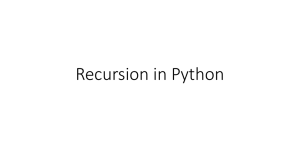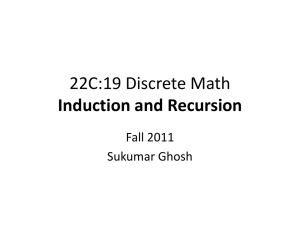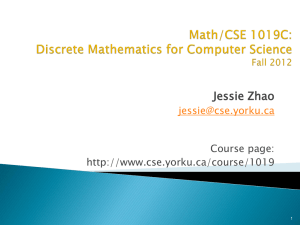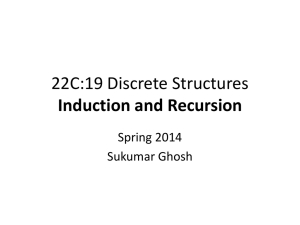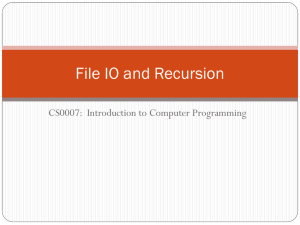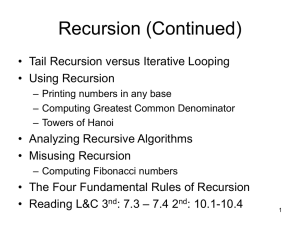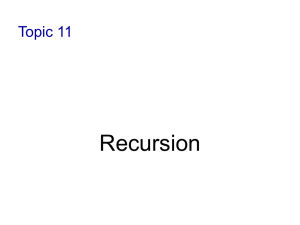Chapter 14
advertisement
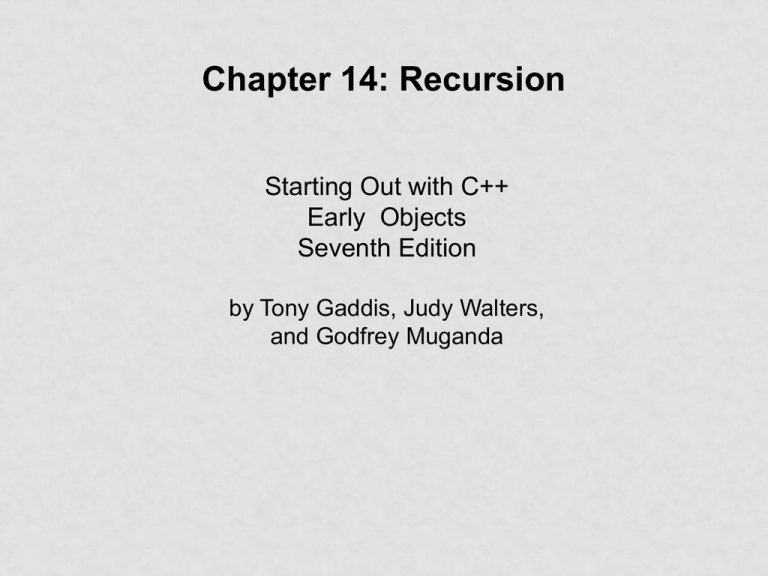
Chapter 14: Recursion
Starting Out with C++
Early Objects
Seventh Edition
by Tony Gaddis, Judy Walters,
and Godfrey Muganda
TOPICS
14.1
14.2
14.3
14.4
14.5
14.6
14.7
14.8
14.9
Introduction to Recursion
The Recursive Factorial Function
The Recursive gcd Function
Solving Recursively Defined Problems
A Recursive Binary Search Function
The QuickSort Algorithm
The Towers of Hanoi
Exhaustive and Enumeration Algorithms
Recursion Versus Iteration
14-2
14.1 INTRODUCTION TO RECURSION
• Recursive function: a function that
calls itself.
• Solving problems that can be
broken down into smaller or simpler
sub-problems of the same type.
• Generally used to replace a loop
14-3
RECURSION
• Advantages
• Simple & clean solutions to complex
problems
• Short solutions
• Disadvantages
• Overhead of repeated function calls
• Inherent efficiency of some solutions
14-4
TWO PARTS OF RECURSIVE FUNCTION
• Base Case (Base Step): point at which
the splitting of the problem stops.
• Recursive Step: Function calls itself with
a smaller parameter
• Both parts MUST be present
• Generally, no loops in recursive
function
14-5
SOME RECURSIVE PROBLEMS
• Factorial
• Fact(N) = N * Fact(N-1)
• Fact (1) = 1, Fact(1) = 1, Fact(2) = 2
• Exponentiation (Ny)
• Exp(N, y) = N * Exp(N,y-1)
• Fact(N,1) = N
• BinarySearch
• BinS(Size) = BinS(Size/2)
• BinS(1) = T or F
14-6
RECURSIVE FUNCTIONS
Consider a function for solving the
count-down problem from some
number num down to 0:
• base case: num is already 0: the
problem is solved & we “blast off!”
• If num is greater than 0, count off num &
then recursively count down from num-1
14-7
RECURSIVE FUNCTIONS
A recursive function for counting down to 0:
void countDown(int num)
{
if (num == 0)
cout << "Blastoff!";
else
{
cout << num << ". . .";
countDown(num-1); // recursive
}
// call
}
14-8
WHAT HAPPENS WHEN CALLED?
If a program contains a line like countDown(2);
1. countDown(2) generates the output 2...,
then it calls countDown(1)
2. countDown(1) generates the output 1...,
then it calls countDown(0)
3. countDown(0) generates the output
Blastoff!, then returns to countDown(1)
4. countDown(1) returns to countDown(2)
5. countDown(2)returns to the calling function
14-9
WHAT HAPPENS WHEN CALLED?
first call to
countDown
num is 2
OUTPUT:
2...
countDown(1);
second call to
countDown
num is 1
1...
countDown(0);
third call to
countDown
num is 0
// no
// recursive
// call
Blastoff!
14-10
STOPPING THE RECURSION
• A recursive function MUST include a
test for base cases
• Can be more than one base case.
• In the sample program, the test is:
if (num == 0)
14-11
STOPPING THE RECURSION
void countDown(int num)
{
if (num == 0) // test
cout << "Blastoff!";
else
{
cout << num << "...\n";
countDown(num-1); // recursive
}
// call
}
14-12
STOPPING THE RECURSION
• With each recursive call, parameter
controlling the recursion moves closer
to base case
• Eventually, parameter reaches the
base case & chain of recursive calls
terminates
• Usually, parameter – x or parameter / x
14-13
STOPPING THE RECURSION
void countDown(int num)
{
if (num == 0)
// base case
cout << "Blastoff!";
else
{ cout << num << "...\n";
countDown(num-1);
Value passed to
}
recursive call is
}
closer to base case
of num = 0.
14-14
WHAT HAPPENS WHEN CALLED?
•
Each time a recursive function is called, a
new copy of the function runs, with new
instances of parameters & local variables
being created
•
As each copy finishes executing, it returns
to copy of function that called it
•
When initial copy finishes executing, it
returns to part of the program that made
initial call to function
14-15
TYPES OF RECURSION
• Direct recursion*
• a function calls itself
• Indirect recursion
• function A calls function B, and function B
calls function A. Or,
• function A calls function B, which calls …,
which calls function A
14-16
14.2 THE RECURSIVE FACTORIAL FUNCTION
• Factorial of nonnegative integer n is
product of all positive integers less or
equal to n
• Factorial of n is denoted by n!
• The factorial of 0 is 1
0!=1
n ! = n x (n-1) x … x 2 x 1 if n > 0
14-17
RECURSIVE FACTORIAL FUNCTION
• Factorial of n can be expressed in
terms of the factorial of n-1
0!=1
n ! = n x (n-1) !
• Recursive function
int factorial(int n)
{ if (n == 0) return 1;
else
return n *factorial(n-1);
}
14-18
MODIFIED RECURSIVE FACTORIAL
int Fact(int n)
{ if (n == 0)
return 1;
else if (n == 1 || n == 2)
return n;
else
return n * Fact(n-1);
}
Advantage or Disadvantage??
14-19
FACTORIAL EXAMPLE
Fact(6) =
6 * Fact(5) =
5 * Fact(4) =
4 * Fact(3) =
3 * Fact(2) =
2
Now return values back to previous call.
If stop at 2, why the base cases for 1 & 0??
14-20
14.3 THE RECURSIVE GCD FUNCTION
• Greatest common divisor (gcd) of 2
integers x & y is largest number that
divides both x & y
• The Greek mathematician Euclid
discovered that
• If y divides x, then gcd(x, y) is just y
• Otherwise, the gcd(x, y) is the gcd of y &
remainder of x divided by y
14-21
THE RECURSIVE GCD FUNCTION
int gcd(int x, int y)
{
if (x % y == 0) //base case
return y;
else
return gcd(y, x % y);
}
14-22
RECURSIVE GCD EXAMPLE
gcd(10,5) = // 10%5 = 0
return 5
~~~~~~~~~~~~~
gcd(49,14) = // 49%14 = 7
gcd(14,7) = //14%7
return 7
= 0
14-23
14.4 SOLVING RECURSIVELY DEFINED
PROBLEMS
• The natural definition of some
problems leads to a recursive solution
• Example: Fibonacci numbers:
0, 1, 1, 2, 3, 5, 8, 13, 21, ...
• After the starting 0, 1, each term is the
sum of the two preceding terms
• Recursive solution:
fib(n) = fib(n – 1) + fib(n – 2);
• Base cases: n == 0, n == 1
14-24
RECURSIVE FIBONACCI FUNCTION
// n is (n-1)th element in sequence
int fib(int n)
{
if (n <= 0)
// base case
return 0;
else if (n == 1)
// base case
return 1;
else
return fib(n – 1) + fib(n – 2);
}
14-25
FIBONACCI EXAMPLE
Fib(5) =
Fib(4) + Fib (3)
Fib(3) + Fib (2) + Fib(2) + Fib(1)
Fib(2) + Fib(1) + Fib(2) + Fib(1)
+Fib(1) + Fib(0) + 1
2 more levels
*Recursion is NOT most efficient way to solve
this problem. In fact, a very inefficient way
14-26
14.8 RECURSION VS. ITERATION
• Benefits (+), disadvantages for recursion:
+Natural formulation of solution to certain
problems
+Results in shorter, simpler functions
• May not execute very efficiently
• Benefits (+), disadvantages for iteration:
+Executes more efficiently than recursion
• May not be as natural as recursion for some
problems
14-27
HOMEWORK
Chapter 14 (p. 930)
• Questions 1 – 8
• Programming Challenges
• 1, 2, 4, 5, 7
14-28
14.5 A RECURSIVE BINARY SEARCH
FUNCTION
• Assume an array a, sorted in
ascending order, & an item X
• Write a function that searches for X
within the array a
• returns index of X if it is found,
• returns -1 if X is not in the array
14-29
RECURSIVE BINARY SEARCH
A recursive strategy for searching a
portion of the array from index lo to
index hi is to
set m to index of the middle portion of
array:
lo
m
hi
14-30
RECURSIVE BINARY SEARCH
lo
m
hi
If a[m] == X, found X, so return m
If a[m] > X, recursively search a[lo..m-1]
If a[m] < X, recursively search a[m+1..hi]
14-31
RECURSIVE BINARY SEARCH
int bSearch(int a[],int lo,int hi,int
X)
{
int m = (lo + hi) /2;
if(lo > hi) return -1;
// base
if(a[m] == X) return m;
// base
if(a[m] > X)
return bsearch(a,lo,m-1,X);
else
return bsearch(a,m+1,hi,X);
}
14-32
14.6 THE QUICKSORT ALGORITHM
• Fast, recursive sort algorithm for arrays
• First, determine an element to use as
pivot value
• can select pivot by any strategy
• “hope” the pivot is near the middle of the
range of values in the array
14-33
THE QUICKSORT ALGORITHM
pivot value
sublist 1
sublist 2
• Then, values are moved so that elements
in sublist1 are < pivot and elements in
sublist2 are >= pivot
• Algorithm then recursively sorts sublist1
and sublist2
• Base case: sublist has size <=1
14-34
14.7 THE TOWERS OF HANOI
• Setup: 3 pegs, one has n disks on it, the other
two pegs empty. The disks are arranged in
increasing diameter, top bottom
• Objective: move the disks from peg 1 to peg
3, observing
• only one disk moves at a time
• all remain on pegs except the one being moved
• a larger disk cannot be placed on top of a smaller
disk at any time
14-35
THE TOWERS OF HANOI
How it works:
n=1
Move disk from peg 1 to peg 3.
Done.
n=2
Move top disk from peg 1 to peg 2.
Move remaining disk from peg 1 to peg 3.
Move disk from peg 2 to peg 3.
Done.
14-36
OUTLINE OF RECURSIVE ALGORITHM
If n==0, do nothing (base case)
If n>0, then
a. Move the topmost n-1 disks from peg1 to
peg2
b. Move the nth disk from peg1 to peg3
c. Move the n-1 disks from peg2 to peg3
end if
14-37
14.8 EXHAUSTIVE AND ENUMERATION
ALGORITHMS
• Enumeration algorithm: generate all
possible combinations
Example: all possible ways to make change
for a certain amount of money
• Exhaustive algorithm: search a set of
combinations to find an optimal one
Example: change for a certain amount of
money that uses the fewest coins
14-38
